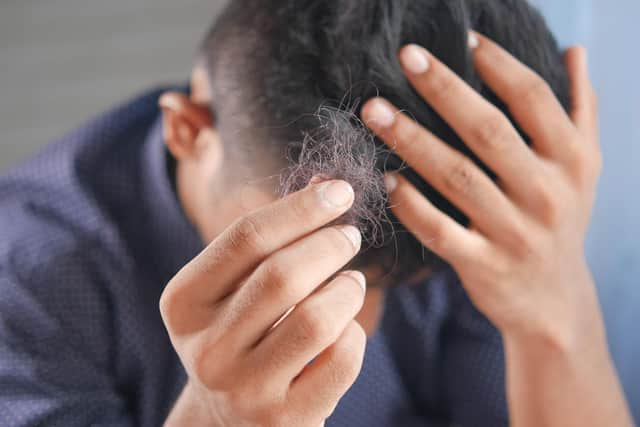Alopecia: What you need to know about alopecia and what it is like to live with
and live on Freeview channel 276
It affects men and women equally, though it most commonly presents in adolescence or early adulthood.
Male and female pattern baldness is the most common types of alopecia.
Advertisement
Hide AdAdvertisement
Hide AdAlopecia refers generally to hair loss in parts of the body that usually have hair.


There are a number of different types, defined on charity Alopecia UK’s website, including: alopecia totalis: When a person loses all hair on the scalp. Alopecia universalis: When a person loses all hair on their body, which is very rare. Alopecia areata: When a person develops patchy baldness somewhere on their body, including the scalp, beard area, eyebrows, eyelashes, armpits, inside the nose, or ears. Alopecia areata is an autoimmune disease. Trichotillomania is a condition that leads to an overwhelming urge to pull out hair.
Kate Constable, 38 from Horsham, always had thin hair as a child but it became thinner in her mid to late teens.
“I started to notice bald patches appearing along my front hair line and then on the crown of my head when I was 21/22 years old.
Advertisement
Hide AdAdvertisement
Hide Ad“It did start to affect my self confidence and I was trying everything possible with hair products, hair styles and dying my hair to make it look thicker and fuller but this only lasted for a brief amount of time. I tried various hair lotions that ‘guaranteed hair regrowth’ but they didn’t work.”


Kate visited her GP who referred her to a specialist in London, who recommend I embrace it naturally or wear a wig.
Kate said: “I left there feeling heartbroken and annoyed and the thought of wearing a wig was a huge no no as I thought it would be so obvious to everyone as I was envisaging the wigs you get with fancy dress costumes and that I would have the mick taken out of me and have people point and stare.”
A few years ago Kate was recommended a hairdresser in Worthing that specialised in wigs, they went through the whole catalogue together and Kate was able to try on various styles in all shapes, sizes and colours.
Advertisement
Hide AdAdvertisement
Hide AdShe said: “When I eventually found the right one I left there feeling on cloud nine, I felt like a woman again, felt feminine and no longer felt like people were staring at me.


"There seems to be such a stigma attached to hair loss, if you saw a bald man walking down the road you wouldn’t look twice, but a bald woman raises a lot of eyebrows, whispering or even pity.”
She was 28 when she got her first wig.
She said: “I don’t know where I would be emotionally or mentally without them. I personally do not have the confidence to go out in public bald but I have so much admiration for those that do and hope one day that I can.”
Causes are unknown, although it is believed stress could be a catalyst, and available treatments offer no guarantees of success.
Advertisement
Hide AdAdvertisement
Hide AdLiz Segal, from Hastings, has LLP which is rarer but where some people may make a full recovery from alopecia areata, LLP is permanent and irreversible.
The follicles are killed off by the immune system and leaves permanent scarring which is the bald patches.
Liz said: “I have been dealing with this since 2016 but it took two years to get the diagnosis while burning pain caused sleep deprivation and then an emotional rollercoaster coming to terms with the loss.
“Thankfully things have calmed down after a combination of immunosuppressants and change in diet.”
Advertisement
Hide AdAdvertisement
Hide AdAlopecia areata cannot be cured, but there are treatment options.
Many include steriods, such as topical steroids which are creams, ointment, lotions, or foams; systemic corticosteroids which are steroids that are taken orally as a pill or injection in the muscle; intralesional corticosteroids, steroids that are injected into the affected areas just underneath the skin using a fine needle.
And there is contact immunotherapy. The aim of this form of treatment is to induce a local allergic skin reaction (contact dermatitis) that stimulates hair re-growth by distracting the immune system from attacking the hair follicles. In the UK Diphenylcyclopropenone (DPCP) is the most commonly used treatment.
There is also topical minoxidil, which comes in a liquid or foam that is applied to the scalp, and immunosuppressive treatments such as ciclosporin, methotrexate, and azathioprine.
Ariane Murrell has had alopecia for more than 20 years.
Advertisement
Hide AdAdvertisement
Hide AdHer hair started to fall out when she was 12, she explained there were no warning signs leading up to her hair falling out, but her GP at the time believed she had had a virus and it was due to her immune system.
It took six months for Ariane’s hair to fall out completely and her older sister lost her hair a few months later, her sister’s hair grew back thicker after a year or so.
She said: “It affected my confidence and being a preteen. I lost out on the chance of experimenting with hair styles etc.
“I was the prime target in high school for bullies. My mum got me the right support and I made many new alopecian friends.
Advertisement
Hide AdAdvertisement
Hide Ad“It's taken three attempts to find my new identity. I finally succeeded in 2021. I treated myself to a huge head tattoo and yes it hurt a little. I am happy now and if anyone offered me a cure, I would politely decline.”